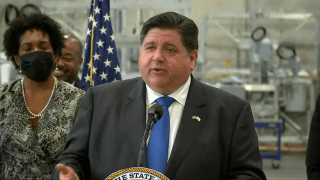
As some states have started offering incentives to convince unemployed individuals to return to the workforce, Illinois is now considering such an action, Gov. J.B. Pritzker said Monday.
"We're looking at all the options," the governor noted as he addressed reporters at the opening of the K-Town Business Center in Chicago's North Lawndale neighborhood.
As first reported in late May, nearly all the nation’s Republican governors decided to cut off a $300-a-week federal unemployment benefit that they and many business executives blame for discouraging the unemployed from seeking jobs.
However, Gov. Pritzker stated at the time that wouldn't be the case in Illinois, explaining unemployed residents will receive an extra $300 a week in federal unemployment benefits until the payments expire on Sept. 6.
Feeling out of the loop? We'll catch you up on the Chicago news you need to know. Sign up for the weekly Chicago Catch-Up newsletter here.
Pritzker previously said he doesn’t support ending the benefits or reinstating job search requirements because there are people who have “legitimate reasons for remaining on unemployment” that are directly related to the pandemic.
Four states - Arizona, Montana, New Hampshire and Oklahoma — are paying return-to-work bonuses in lieu of the enhanced unemployment benefits to encourage residents to accept jobs, CNBC reported.
Arizona's Back to Work program offers one-time $1,000 payments to unemployment recipients who accept a part-time job and $2,000 to full-timers.
Local
New Hampshire, via its Summer Stipend Program, is paying $500 and $1,000 bonuses for part- and full-time positions, respectively.
Montana and Oklahoma are paying $1,200 to those who accept full-time work.
Research suggests that roughly half the unemployed are receiving more income from jobless benefits, when you include the weekly $300 federal supplement, than their former jobs paid them. An analysis by Bank of America found that people who earned under $32,000 at their old jobs are likely now receiving more in unemployment aid than they did from working.
Yet some point to the steady decline in the number of Americans receiving jobless benefits as evidence that most of the unemployed are still willing to take jobs when they’re available.
“Today’s data indicates that unemployment aid is not keeping workers on the sidelines,” said Andrew Stettner, a senior fellow at The Century Foundation. “Emergency unemployment aid is doing what it is meant to do: Serving as a temporary lifeline while workers search for and return to work.”
Speaking Monday, Pritzker noted a "big consideration" is making sure whether enough child care is available for parents who hope to head back to the workplace.
"We've been working to expand that in order to help them get back to work," he said. "Listen, people who are not working not right now want to go back to work. So, we just need to make it easier for them to do so."



